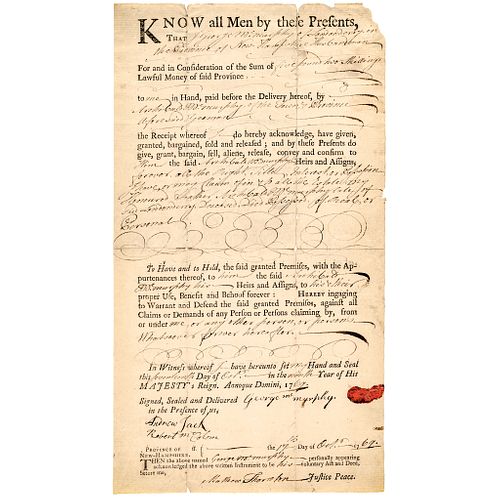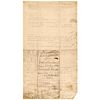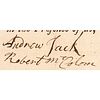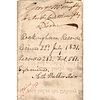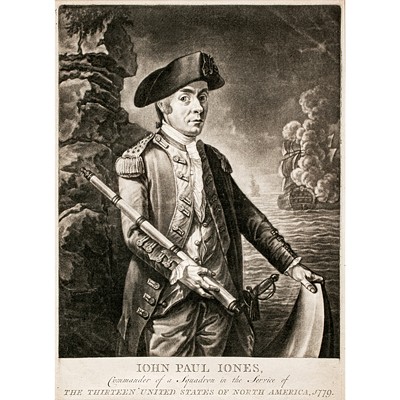MATTHEW THORNTON, The LAST Declaration of Independence Signer, Signed Document
Lot 50
About Seller
Early American History Auctions
1520 Commerce St., #312
Winchester, VA 22601
United States
Categories
Estimate:
$1,400 - $1,800
Absentee vs Live bid
Two ways to bid:
- Leave a max absentee bid and the platform will bid on your behalf up to your maximum bid during the live auction.
- Bid live during the auction and your bids will be submitted real-time to the auctioneer.
Bid Increments
| Price | Bid Increment |
|---|---|
| $0 | $10 |
| $200 | $20 |
| $300 | $25 |
| $500 | $50 |
| $1,000 | $100 |
| $2,000 | $200 |
| $3,000 | $250 |
| $5,000 | $500 |
| $10,000 | $1,000 |
| $20,000 | $2,000 |
| $30,000 | $2,500 |
| $50,000 | $5,000 |
| $100,000 | $10,000 |
| $200,000 | $20,000 |
| $300,000 | $25,000 |
| $500,000 | $50,000 |
About Auction
By Early American History Auctions
Jan 23, 2021
Set Reminder
2021-01-23 12:00:00
2021-01-23 12:00:00
America/New_York
Bidsquare
Bidsquare : Early American History Auction of Autographs, Americana, Political & Maps
https://www.bidsquare.com/auctions/early-american-history-auctions/early-american-history-auction-of-autographs-americana-political-maps-6311
311 Lots of Rare, Historic Autographs, Americana, Civil War Era, George Washington, Abraham Lincoln, Slavery & Black History, Revolutionary War Era, Colonial America, Federal Period, War of 1812, Colonial Currency, Indian Peace Medals & more... Early American History Auctions auctions@earlyamerican.com
311 Lots of Rare, Historic Autographs, Americana, Civil War Era, George Washington, Abraham Lincoln, Slavery & Black History, Revolutionary War Era, Colonial America, Federal Period, War of 1812, Colonial Currency, Indian Peace Medals & more... Early American History Auctions auctions@earlyamerican.com
- Lot Description
Autographs
Rare MATTHEW THORNTON Signed Document, he was The Second to the Last Signer on the Declaration of Independence
MATTHEW THORNTON (1714-1803), a.k.a. the LAST Signer of the Declaration of Independence representing New Hampshire. He was a Physician, President of the New Hampshire Provincial Congress (1775), Speaker of the NH House of Representatives (1776), Member of the Continental Congress. He arrived late to Philadelphia in November 1776 and was granted permission to belatedly Sign his name to the Declaration of Independence, making him the second to the last person to sign the document.
October 17, 1769-Dated Colonial Pre Revolutionary War Era, Partly-Printed Document Signed, "Matthew Thornton" as Justice of the Peace, signed on a one page legal document that measures 12.25" x 7", Londonderry, New Hampshire, Fine. This Document records that in consideration of five pounds two shillings paid by Archibald Murphy to George Murphy, George released all claims forever to the premises and appurtenances of the estate which he sold to Archibald, signs his name with a red wax official seal next to his signature. Here, Thornton Signs that George Murphy appeared before him and acknowledges, "the above written Instrument to be his voluntary Act and Deed." This Document is written on laid period paper with a British watermark and has some pinholes at fold intersections. Thornton's bold brown signature measures a full 2.75" in length; a fold split separates the final 1/4" of the flourish from the rest of the signature. Collectors know that Matthew Thornton is in the top half of Declaration of Independence Signers in scarcity.
Thornton was not present on August 2, 1776, at a formal Signing of the Declaration of Independence. He was elected to the Continental Congress but did not arrive in Philadelphia until November 1776, after the debates on Independence had concluded. However, he requested permission to sign the founding document, which was granted, and that is why his signature is the very last one seen in the far right column.
Matthew Thornton (1714 - June 24, 1803) was an Irish-born signer of the United States Declaration of Independence as a representative of New Hampshire.
Thornton was born in Ireland in 1714 to James and Elizabeth (ne Jenkins) Thornton, who were Scots-Irish. At the time of the Siege of Derry in 1689, James Thornton lived on a farm within a mile of Derry and this is where Matthew was probably born.
In 1716, Thornton's family immigrated to North America when he was three years old, settling first in Wiscasset, Maine. On July 11, 1722, the community was attacked by Native Americans. James and Elizabeth Thornton fled from their burning home with Matthew, moving shortly thereafter to Worcester, Massachusetts. Thornton completed studies in medicine at Leicester. He became a physician and established a medical practice in Londonderry, New Hampshire. He was appointed as a surgeon for the New Hampshire Militia troops in an expedition against Fortress Louisbourg in 1745. He served in the New Hampshire Provincial Assembly from 1758-1762, had royal commissions as justice of the peace, and served as colonel in the militia from 1775 until his resignation in 1779.
In 1760 Thornton married Hannah Jack, and the couple had five children. Thornton became a Londonderry selectman, a representative to and President of the Provincial Assembly, and a member of the Committee of Safety, drafting New Hampshire's plan of government after dissolution of the royal government, which was the first state constitution adopted after the start of hostilities with England.
He served as the President of the New Hampshire Provincial Congress in 1775, and from January to September 1776, as Speaker of the New Hampshire House of Representatives. He was elected to the Continental Congress after the debates on independence had occurred, but as he did not arrive in Philadelphia until November 1776, he was granted permission to actually sign the Declaration of Independence four months after the formal signing in July, which is why his is the last signature at lower right.
- Shipping Info
-
Early American provides in-house worldwide shipping. Please contact us directly if you have questions about your specific shipping requirements.
-
- Buyer's Premium



 EUR
EUR CAD
CAD AUD
AUD GBP
GBP MXN
MXN HKD
HKD CNY
CNY MYR
MYR SEK
SEK SGD
SGD CHF
CHF THB
THB